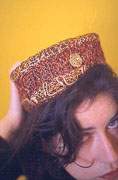
- ALISON BAILEY SMITH
Yes, it’s true, for those of you who had the same skeptical initial response as I had. Alison Bailey Smith does use wire from inside discarded television sets to make her wearable jewelry, corsets and hats. A strange place to get materials, but the art she creates is stunning. The wire is much thinner than I imagined. It looks like embroidery thread, and Alison’s adept twisting of it gives the wire a soft look, increasing this illusion. TV wire also seems to come in as many colours as embroidery thread. Because of the fine detail of her work, even more than most visual art, photos do not do her creations justice. Neither can photographs show the movement inherent in some of the pieces. “A lot of my pieces move and change when you wear them”, she explains. “Some of the hats have parts on top that move; some of the corsets have parts that sway on the bottom. I don’t like it when i find out that people are just going to put one of my pieces on their coffee table. On the other hand, a lot of people wear them and put them on their coffee table; that’s what I like best.”
Before coming to Canada, Alison lived in Australia for four years, and before that, in Edinburgh. “It’s hard on my work”, she says. “I just get known in one place, and then I have to start over again in the next place. But I find the marketing part exciting. And it seems to be easier to get established each time, I think because I’m becoming more experienced in selling myself.
I ask her how long it takes her to make a piece. “It’s takes me a week to make a hat . . . and an hour to take apart the TV. I’ve had to turn down TV’s lately; I’ve got so many people bringing them to me.” TV wire isn’t the only thing Alison uses either. She shows me pieces made with audio tape. She has twisted it around, to make twine, and it is certainly well disguised. One of her friends, a weaver, gave Alison her discarded pieces of yarn, the ones that were too short for her to use. “They’re a great length for me”, Alison comments. She has even used plastic candy wrappers. “They don’t deteriorate”, she assures me. “And that’s scary to think about; all that stuff sitting in landfill sites.”
She began using recycled materials when she was in her last year of an Honours degree at the Edinburgh College of Art. “I was working with silver wire, but it kept melting on me. Then my brother handed me some wire out of an old radio of his, and said ‘here, you’re in art school, make something out of this.’” So she started playing with it, and ended up making a little skull cap. When she took her work to be marked, she had the skull cap and all the jewellery she’d made out of silver, her instructor looked at the skull cap and said “this is really good.” “I was really surprised”, Alison continues, “ because the skull cap had been fun and spontaneous, and it was more craft orientated then jewelry orientated, and I thought I’d have to ignore it because of that.” Alison went on to do a post-graduate degree in Design, where, because there is a lot more freedom, she was able to focus on her innovative use of materials.
Alison sells her work locally out of Harbinger Gallery in Waterloo. Those of us living in Guelph have the fortunate opportunity to see her more locally than that, though. She is exhibiting in our own backyard October 16 to October 18 during the Guelph Studio Tour. She will be transporting “as many pieces as [she] can” from her home to Asterisk Communications on Paisley Street, in order to be in the downtown area. She will also be an exhibitor at the “With These Hands” Exhibition at the Ontario Heritage Centre in Toronto, which runs from November 6 to November 8 of this year.
Christime Stodart, September, 1998
